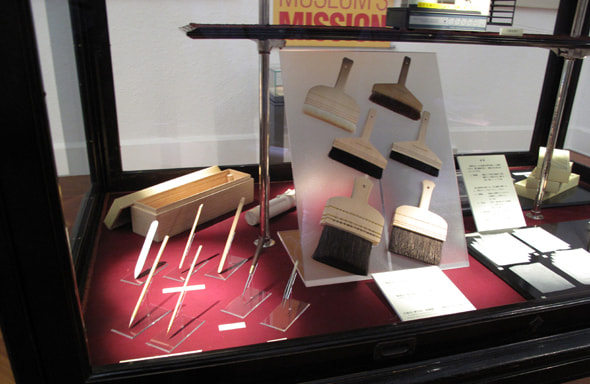
A variety of tools for preservation
Honkan, Room 17 "Preserving Our Cultural Properties"
Kanba : Room 17 in Honkan is a section of a permanent exhibition where preservation of cultural properties is introduced to visitors in an easily understood manner. This kind of permanent exhibition sections were recently opened. The sections were opened just two years ago. Many people have thought that a museum has some permanent exhibition sections. In order for visitors to understand that a variety of museum activities, including research and storage, has been carried out behind the exhibition, we specially set up this section of storage. On the board attached on the front wall, how the Tokyo National Museum's conservation division thinks about the preservation of cultural properties is systematically explained. First of all, the fact that cultural properties are inevitably damaged if they are opened to the public is explained.
Types of damage are introduced as compared to its causes. Then, the important things are how we understand the damage and what kind of decisions we can make. We call it "medical examination of cultural properties." As with physical diagnosis, we check cultural properties using a variety of scientific instruments and the unaided eye. When a diagnosis of cultural properties is completed, it becomes clear that how the items are stored or repaired. Based on the result, cultural properties should be prevented from further damage. We call it "preventive conservation." There are a variety of approaches for the storage. We take preventive measures to protect the environment surrounding cultural properties. For example, we control the temperature, humidity and living things, such as mold and insects, shut off foul air, such as atmospheric and indoor pollution, from the museum, and adjust the brightness of lights which are necessary for exhibits as well as the quality of the lights.
Then, we repair damage which could not be avoided by taking preventive measures. There are a variety of repair methodologies, and each damage is repaired with an appropriate method. However, the purpose of cultural properties' restoration is not necessarily to bring them back to the original state, but to hand down them to the next generation while maintaining the present state of the cultural properties. Also, we do not try to obscure portions to which repairs were applied. We think that, since cultural properties have been passed down to the present, their damage is also considered to be part of the cultural properties. Repairs performed in the present time should not obscure the damage. It is important to preserve the cultural properties as they really are. During the sequence of preservation (diagnosis, prevention, and repair), we keep records at each process. By accumulating the records, we can now accurately understand the past situation, and decide what measures should be taken for the sake of the future. (continued in the lower column)
This is "Kiri-bako," a box made of paulownia wood. I think average households also have Kiri-bako in which important things are stored. This museum also stores a variety of cultural properties in it, and places it in a storehouse. When a lid of Kiri-bako is closed, humidity inside it is stabilized. Even when humidity in a room changes, a changing range of humidity in the box is just a little more than one-tenth of that of the room. A stabilization of humidity is important for cultural properties, and Kiri-bako is very suitable for that purpose. This is a model of the base-isolating device. Visitors can look at the structure of the device. It is placed between a display case and the floor. The pink box as large as a cigarette box is a device called "data logger" which records temperatures and humidity. A hair hygrometer with thermometer is placed at the upper part. This museum uses both the data logger and hair hygrometer with thermometer to regularly record temperatures and humidity at several hundred places and keep the records. 50 to 60 % humidity is appropriate for cultural properties. We use this recorder to check whether humidity is maintained within the range. If humidity deviates from the range, we will take some measures. Small grains in the boxes next to the recorder are humidity control agents, which are used to stabilize humidity in display cases. Thousands of the boxes are placed in this museum. When exhibits are replaced with new ones for a special or permanent exhibition, those boxes are also replaced to stabilize humidity in display cases.
Original items are displayed in the display case behind the model of the base-isolating device. This time, tea utensils and plates happen to be displayed. All of them were repaired by the technique called "Kintsugi," or repair of a ceramic piece with gold-dust lacquer. Gold is too conspicuous in items repaired by the technique, so it is not an appropriate repair method in the present day. However, if items repaired by the Kintsugi technique has been valued at their true worth and fixed portions have also been part of the items, we do not venture to remove them and repair the items again. There are two cases; one is to reject the past repairs and replaced them with the present ones, and another is to keep the past ones as they are. When the repaired portions will be damaged in the future, they might be replaced, but, for the time being, the items are maintained as they are. There is no solvent that can melt Japanese lacquer. It is unsafe to scrape Japanese lacquer, so if the lacquer is damaged in the future, we would take future methods.
Q : Nowadays, are you using synthetic adhesives?
Kanba : Well, we have been using synthetic adhesives in many cases. However, we also use other glues if needs arise. Synthetic adhesives are used for these ceramics, and animal or vegetable glues, such as Nikawa glue and seaweed glue, are used for paper and wood works. (continued in the lower column)
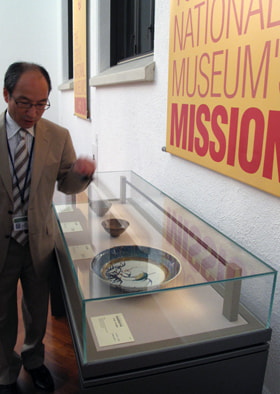
Exhibition introducing the past repair examples
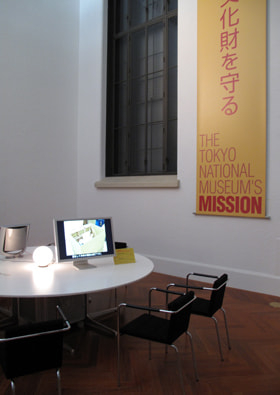
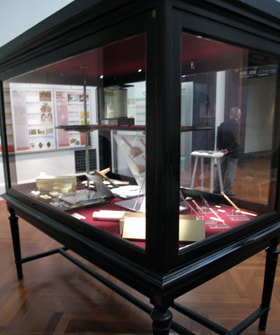
Historical display case
Q : Are these tools used for repairs?
Kanba : Tools and materials, which are used for repairs, are displayed in the middle of the room. Knives, paper and spatulas, which are used in the Soko technique for repairing cultural properties, including paintings and writings, are displayed at the lower part of the display case. Humidity control agents, used when displaying items, and a model of the base-isolating device are displayed behind the tools. Also, this display case itself has a distinct feature. The case has historical value. It was imported from England in the Meiji Period, and used in an exhibition room. Such an old display case is also historically important in terms of the history of display cases. We have refurbished and used it to display items in the present situation. (continued in the upper right column)
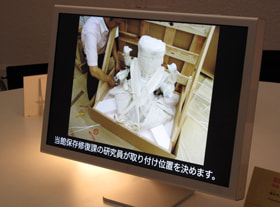
File films at the section of "Preserving Our Cultural Properties"
File films and original items at the section of "Preserving Our Cultural Properties" in Room 17
Kanba : Transportation and restoration methods of cultural properties are introduced in this section. There are two programs; one is the transportation and vibration investigation of cultural properties, and another is this program. This is a scene in which a Buddhist statue is loaded onto a truck, transferred to Nara. After this program, you can see another program in which repairs of a picture depicted on silk and a statue of Xuanzang are filmed. There are English and Japanese language versions for each program. Foreign visitors have seats and watch the programs from time to time. In this way, various aspects of the Tokyo National Museum's approach to the preservation of cultural properties are introduced in Room 17. The original items I mentioned just before are regularly replaced with other items. As for the historical display case at the right side, we are planning to replace it with new one. I think it is better to reorganize all exhibits once every few years.(continued in the next page)
Kanba: Room 17 in Honkan is a section of a permanent exhibition where preservation of cultural properties is introduced to visitors in an easily understood manner. This kind of permanent exhibition sections were recently opened. The sections were opened just two years ago. Many people have thought that a museum has some permanent exhibition sections. In order for visitors to understand that a variety of museum activities, including research and storage, has been carried out behind the exhibition, we specially set up this section of storage. On the board attached on the front wall, how the Tokyo National Museum's conservation division thinks about the preservation of cultural properties is systematically explained. First of all, the fact that cultural properties are inevitably damaged if they are opened to the public is explained.
Types of damage are introduced as compared to its causes. Then, the important things are how we understand the damage and what kind of decisions we can make. We call it "medical examination of cultural properties." As with physical diagnosis, we check cultural properties using a variety of scientific instruments and the unaided eye. When a diagnosis of cultural properties is completed, it becomes clear that how the items are stored or repaired. Based on the result, cultural properties should be prevented from further damage. We call it "preventive conservation." There are a variety of approaches for the storage. We take preventive measures to protect the environment surrounding cultural properties. For example, we control the temperature, humidity and living things, such as mold and insects, shut off foul air, such as atmospheric and indoor pollution, from the museum, and adjust the brightness of lights which are necessary for exhibits as well as the quality of the lights.
Then, we repair damage which could not be avoided by taking preventive measures. There are a variety of repair methodologies, and each damage is repaired with an appropriate method. However, the purpose of cultural properties' restoration is not necessarily to bring them back to the original state, but to hand down them to the next generation while maintaining the present state of the cultural properties. Also, we do not try to obscure portions to which repairs were applied. We think that, since cultural properties have been passed down to the present, their damage is also considered to be part of the cultural properties. Repairs performed in the present time should not obscure the damage. It is important to preserve the cultural properties as they really are. During the sequence of preservation (diagnosis, prevention, and repair), we keep records at each process. By accumulating the records, we can now accurately understand the past situation, and decide what measures should be taken for the sake of the future.

Exhibition introducing the past repair examples
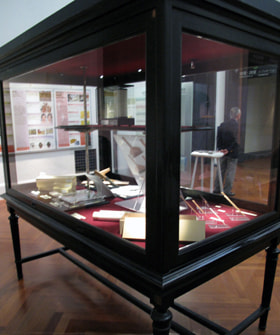
Historical display case
Q: Are these tools used for repairs?
Kanba: Tools and materials, which are used for repairs, are displayed in the middle of the room. Knives, paper and spatulas, which are used in the Soko technique for repairing cultural properties, including paintings and writings, are displayed at the lower part of the display case. Humidity control agents, used when displaying items, and a model of the base-isolating device are displayed behind the tools. Also, this display case itself has a distinct feature. The case has historical value. It was imported from England in the Meiji Period, and used in an exhibition room. Such an old display case is also historically important in terms of the history of display cases. We have refurbished and used it to display items in the present situation.
This is "Kiri-bako," a box made of paulownia wood. I think average households also have Kiri-bako in which important things are stored. This museum also stores a variety of cultural properties in it, and places it in a storehouse. When a lid of Kiri-bako is closed, humidity inside it is stabilized. Even when humidity in a room changes, a changing range of humidity in the box is just a little more than one-tenth of that of the room. A stabilization of humidity is important for cultural properties, and Kiri-bako is very suitable for that purpose. This is a model of the base-isolating device. Visitors can look at the structure of the device. It is placed between a display case and the floor. The pink box as large as a cigarette box is a device called "data logger" which records temperatures and humidity. A hair hygrometer with thermometer is placed at the upper part. This museum uses both the data logger and hair hygrometer with thermometer to regularly record temperatures and humidity at several hundred places and keep the records. 50 to 60 % humidity is appropriate for cultural properties. We use this recorder to check whether humidity is maintained within the range. If humidity deviates from the range, we will take some measures. Small grains in the boxes next to the recorder are humidity control agents, which are used to stabilize humidity in display cases. Thousands of the boxes are placed in this museum. When exhibits are replaced with new ones for a special or permanent exhibition, those boxes are also replaced to stabilize humidity in display cases.
Original items are displayed in the display case behind the model of the base-isolating device. This time, tea utensils and plates happen to be displayed. All of them were repaired by the technique called "Kintsugi," or repair of a ceramic piece with gold-dust lacquer. Gold is too conspicuous in items repaired by the technique, so it is not an appropriate repair method in the present day. However, if items repaired by the Kintsugi technique has been valued at their true worth and fixed portions have also been part of the items, we do not venture to remove them and repair the items again. There are two cases; one is to reject the past repairs and replaced them with the present ones, and another is to keep the past ones as they are. When the repaired portions will be damaged in the future, they might be replaced, but, for the time being, the items are maintained as they are. There is no solvent that can melt Japanese lacquer. It is unsafe to scrape Japanese lacquer, so if the lacquer is damaged in the future, we would take future methods.
Q: Nowadays, are you using synthetic adhesives?
Kanba: Well, we have been using synthetic adhesives in many cases. However, we also use other glues if needs arise. Synthetic adhesives are used for these ceramics, and animal or vegetable glues, such as Nikawa glue and seaweed glue, are used for paper and wood works.


File films at the section of "Preserving Our Cultural Properties"
File films and original items at the section of "Preserving Our Cultural Properties" in Room 17
Kanba: Transportation and restoration methods of cultural properties are introduced in this section. There are two programs; one is the transportation and vibration investigation of cultural properties, and another is this program. This is a scene in which a Buddhist statue is loaded onto a truck, transferred to Nara. After this program, you can see another program in which repairs of a picture depicted on silk and a statue of Xuanzang are filmed. There are English and Japanese language versions for each program. Foreign visitors have seats and watch the programs from time to time. In this way, various aspects of the Tokyo National Museum's approach to the preservation of cultural properties are introduced in Room 17. The original items I mentioned just before are regularly replaced with other items. As for the historical display case at the right side, we are planning to replace it with new one. I think it is better to reorganize all exhibits once every few years.
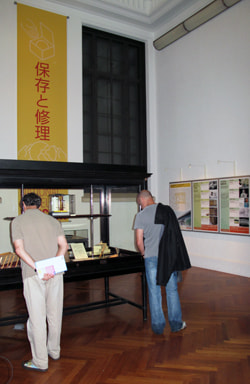
Section of "Preserving Our Cultural Properties"
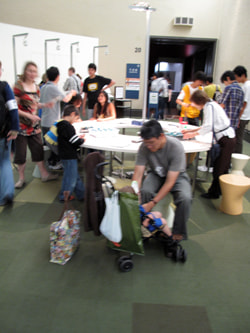
Hands-on exhibition crowded with foreign visitors
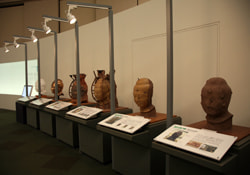
Section of portraits of Buddha - production processes are explained

Section of "Preserving Our Cultural Properties"

Hands-on exhibition crowded with foreign visitors

Section of portraits of Buddha - production processes are explained














